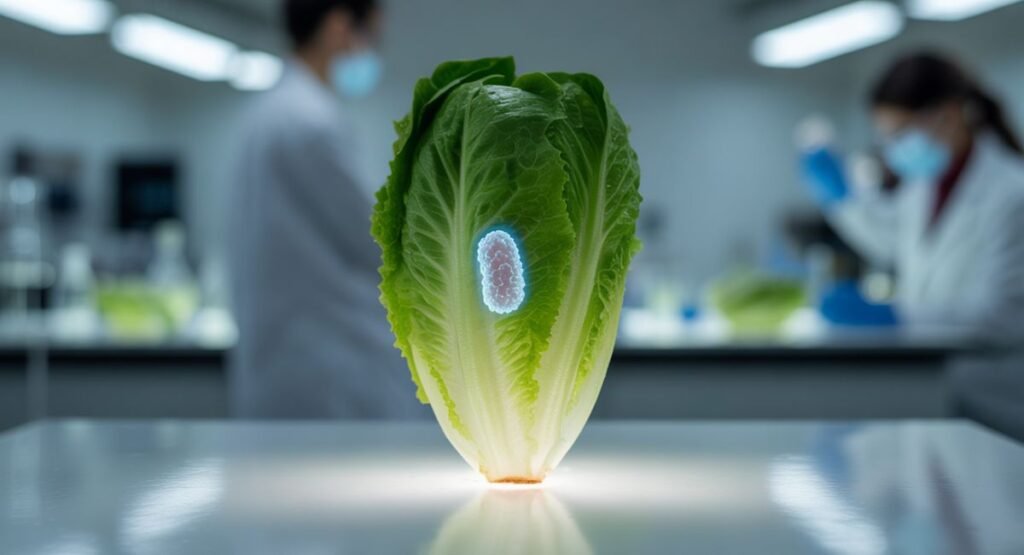Introduction
Food is a basic necessity of human life, and its cleanliness, safety, and quality are directly related to human health. Vegetables, especially fresh leafy vegetables such as romaine lettuce, are consumed worldwide due to their nutritional value and freshness. However, if any negligence is made during their cleaning or cultivation, they can not only be unsafe but also become life-threatening. In recent days, news of the spread of the bacteria called “E. coli” in romaine lettuce has garnered significant attention from international media and research organizations.

What is romaine lettuce?
Romaine lettuce is a type of leafy green vegetable primarily utilized in salad preparations. Its long, dark green, and crisp leaves are not only excellent in taste but also rich in important nutrients such as vitamin A, vitamin K, and folate. This vegetable is very popular in Western countries and is now also being used in Pakistan and other Asian countries.
What is E. coli?
E. coli is a species of bacteria typically present in the human digestive tract and is generally considered to be non-threatening. But some strains, such as E. coli O157:H7, can be very dangerous. This toxic bacteria can enter the body through food or water and cause serious symptoms such as severe gastrointestinal upset, vomiting, diarrhea, and sometimes kidney failure.
How does E. coli get into romaine lettuce?
E. coli is most commonly spread when vegetables are irrigated with dirty water or when hygiene is not maintained during crop cultivation. If animal manure is used as fertilizer and is not properly decomposed, the bacteria can also be introduced into the crop. Sometimes contamination can also occur during harvesting, packaging, and transportation.
Effects of E. coli
- Physical effects:
Severe diarrhea (often bloody)
Abdominal cramps and pain
Vomiting and nausea
Fever
Kidney failure (especially in children and the elderly)
- Psychosocial effects:
Loss of patient confidence
Increased medical costs
Stress on family
Reduced food confidence
Recent outbreak overview
In 2025, the news of the “romaine lettuce E. coli outbreak” was prominent on Google Trends, indicating that it has become a serious global problem. The outbreak has sickened dozens of people in the United States, Canada, and parts of Europe, while some deaths have also been reported. Governments have immediately issued instructions to remove affected batches from the market and take precautionary measures.
Precautions
At the household level:
Wash romaine lettuce or other vegetables thoroughly before use.
If possible, wash with hot water or vinegar.
Throw away damaged or suspicious leaves immediately.
If there is a warning about such a vegetable, stop using it immediately.
At the agricultural level:
Irrigate crops with clean water.
Use manure or other organic fertilizers after thoroughly decomposing them.
Take special care of cleanliness during harvesting, packing, and transport of the crop.
At the government and institutional level:
Monitoring and inspecting the cleanliness of agricultural lands.
Laboratory testing of vegetables sold in the market.
Establish an emergency alert system so that any outbreak can be reported immediately.
Need for public awareness
Most people are unaware of bacteria like E. coli. Therefore, it is important to make the public aware of this disease, its symptoms, and prevention methods. The media, educational institutions, and medical centers should run awareness campaigns in this regard. The principles of food hygiene should also be taught in schools so that hygiene habits become a habit from childhood.
Modern research and development
In the present era, scientific progress has introduced many ways to make food safe. Various types of food testers, chemical-free cleaners, and advanced packaging technology have helped in making food safe. Along with this, with the help of artificial intelligence (AI), it has also become possible to monitor crops and quickly identify bacteria.
Conclusion
The problem of the spread of E. coli in romaine lettuce is not just a food or agricultural problem but a global health challenge. This requires coordinated efforts involving the government, farmers, shopkeepers, health experts, and the public. By adopting cleanliness, awareness, and scientific methods, we can reduce this threat and create a healthy society.



